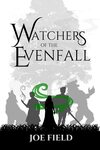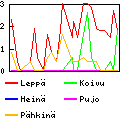Roll through the Dungeon
Traduction: [ Google | Babelfish ]
Catégories : [ Jeux ]
A couple of months ago, I discovered D100 Dungeon, a free print-and-play (at least up to version 2.2) dungeon crawling game where most aspects of the game are randomly generated by rolling dice. While it is yet-another game where you walk into a room, kill the monster and loot the treasure, I was especially enthusiastic about generating the dungeon's map randomly (look at the pictures on BoardGameGeek, some people have taken the time to even make very nice looking maps) I've played a few games before feeling the itch to design such a game myself (game design is something that has been itching every now and then, but without much result until now).
Roll through the Dungeon (RttD) is the result of scratching that itch. The structure of the game is very much inspired by D100 Dungeon, but I changed some of the mechanisms that I didn't like with what I consider better ones.
Inspired by the James Bond 007 role-playing game I played as a teenager in the early '90s, skill tests have an associated success grade, indicating how well your character succeeds in doing a given action. This success grade then determines how much time is spent on doing the action, and in case of fights, how much damage is inflicted to the opponent. This contrasts with D100 Dungeon's two-step fights, where the skill test tells you whether you have hit the opponent, but an second, unrelated roll determines the damage. I find it more intellectually satisfactory that the damage depends on how successful the action has been, rather than being an independent event, but I am aware it is nothing more than a design decision and it does not model reality any better than the two-step model. I'm particularly proud of the nomogram I have designed for computing the success grade, but I must admit that it is actually not very practical (the table is much faster to use, as it does not require manipulating a ruler). But I did it for fun, and that is the kind of geeky stuff I consider fun :)
Another important difference between D100 Dungeon and RttD is the construction of the dungeon's map. The map is a grid of adjacent squares rooms, and in the former game, a single D100 roll determines most of the characteristics in a square: the three exits from the room (corridor, door or wall) and what you find in it (a feature, a monster or nothing). This leads to paradoxical maps, where on one side of a room is a door, but the same side seen from the adjacent room is a solid wall. RttD solves this at the cost of more dice rolls: room sides are determined by independent D10 rolls, and the room's content is yet another roll. That means that you need to roll up to four D10 instead of one D100.
Many design decisions from D100 Dungeon have become apparent when trying to solve the same problems, and have led to the same solutions, reinforcing the similarity between the two games: roll tables are ordered, with the not-go-good stuff at the beginning of the table, and the best stuff at its end. This way, it is possible to get better stuff in some circumstances by offsetting the dice roll (i.e., adding 10 to the D100 roll). This is especially important when searching the rooms: feature rooms may contain a trap, so when searching a feature room, you add 5 to your roll to make it impossible to find a second trap in the same room, as well as increasing the chances to find better stuff.
The hardest thing for me in working on this game has been (and still is) to invent thematic elements, such as monsters, quests, room features, treasures. I tried not to simply copy D100 Dungeon (partly because it's copyrighted, and partly because I wanted to prove myself that I could do it), but it has been really hard. Most monsters and features are coming straight from the NetHack wiki, monster HP and damage are generated by a script to create a progression in the difficulty, but the hardest has been (and still is) quests. Some are more or less direct adaptations from the quests in D100 Dungeon, a few are from my own imagination (especially in the “Ridicule does not kill” they say chapter), but the list of quests is still incomplete (actually, it's the only thing that justifies not releasing a version 1.0 of the game).
I have now played about 25 games of RttD to test the game, fix the problems and try and improve it. I'm a bit sad to say that the novelty is wearing off and that the game feels quite repetitive (it is, by design). What has been the most fun until now has been to use LaTeX again to produce the PDF booklet and to develop macros for generating some parts of the tables and making cross-references. It is nothing fancy, but as a software developer, it's the kind of things I enjoy doing.
I feel like running out of steam about RttD so I don't know how long I will continue working on it; certainly I won't anymore spend several hours daily as I have in the beginning. But as the game is released under Creative Commons BY – SA, anyone can work on it, write changes, and generally improve it. The PDF booklet has a section about developing the game, if you are interested. Among the things that are not implemented yet are curses and blessings (which D100 Dungeon already has), I was considering making them more like NetHacks curses i.e., items you find may be cursed and detrimental to your character if worn or used.
[ Posté le 21 juillet 2020 à 12:40 | pas de commentaire | lien permanent ]






